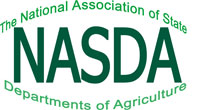The National Association of State Departments of Agriculture (NASDA) is a nonprofit, nonpartisan association that represents the commissioners, secretaries and directors of the state departments of agriculture in all 50 states and four U.S. territories. Established in 1916, our mission is to represent the state departments of agriculture in the development, implementation and communication of sound public policy and programs which support and promote the American agricultural industry, while also protecting consumers and the environment.
 NASDA members are actively involved in ensuring the safety of an abundant food supply, the protection of animal and plant health, and the stewardship of our environment. We are also responsible for promoting agricultural production in our states, fostering new markets for agricultural products, and protecting the economic vitality of rural communities. Our role as regulators of, and advocates for, agriculture gives us a unique perspective on challenges and opportunities facing farmers and ranchers today.
NASDA members are actively involved in ensuring the safety of an abundant food supply, the protection of animal and plant health, and the stewardship of our environment. We are also responsible for promoting agricultural production in our states, fostering new markets for agricultural products, and protecting the economic vitality of rural communities. Our role as regulators of, and advocates for, agriculture gives us a unique perspective on challenges and opportunities facing farmers and ranchers today.
American agriculture is at an historic crossroads: Agricultural producers are presented with new and exciting opportunities, but also face significant challenges that strike at the very heart of our ability to safely and affordably feed, fuel and clothe the world. With the global population expected to climb above 9 billion by 2050, strained water supplies, and millions of acres of farmland leaving agricultural production, American farmers will be expected to do more with less.
Renewed Relationships, New Products, New Markets
The explosion in demand for organic and locally-grown food in recent years has presented farmers with exciting new high value markets for their products. This, coupled with a renewed focus on the importance of diets high in fresh fruits and vegetables, is helping urban consumers reconnect in more personal ways with farmers. It is important that consumers gain a greater understanding that their food doesn’t just appear at the local grocery store, but is instead the product of significant amounts of labor, capital, time and risk on the part of American farmers and ranchers.
The opportunities for agriculture also extend to producing renewable sources of energy. American farmers will soon produce over 36 billion gallons of biofuels, such as ethanol and biodiesel. Significant opportunities also exist to produce other forms of biomass – from corn cobs to tree clippings – that can be converted into energy. Additionally, through sustainable farming practices, farmers can participate in offset markets that help mitigate everything from greenhouse gas emissions to water contamination.
Global markets and export opportunities for food and agricultural products also present exciting possibilities for American producers. Export markets are expanding much faster than the domestic market. NASDA works in conjunction with the U.S. Department of Agriculture’s Foreign Agricultural Service and NASDA’S four affiliated state regional trade groups on a variety of trade promotion projects that are funded primarily through the Market Access Program (MAP). MAP funding helps facilitate trade shows where American food and agriculture products are highlighted. In addition to generic product promotions, MAP funding supports partial reimbursement to small private companies for qualified overseas brand promotion of U.S. agricultural products.
MAP has been a very effective tool in helping American companies enter and expand foreign markets, creating an important connection between food processors, often located in urban areas and agricultural producers. Despite its success, the program is often a target of budget cuts.
NASDA’s collaborative projects include internationally focused domestic and overseas trade shows, as well as information and data projects that connect companies, state and federal government resources. The domestic trade show projects are done in partnership with the World Trade Center Miami, the National Restaurant Association, and the Food Marketing Institute.
Challenges at Hand, Changes Ahead
While exciting opportunities exist, agriculture faces serious challenges.
The global economic recession, coupled with the mislabeling of the H1N1 influenza as “swine flu,” has lead to a critical financial situation in the American pork, dairy and poultry sectors. NASDA has proposed a bold program to stabilize those markets and help keep farmers in business. NASDA’s “Meat the Need” proposal calls for the purchase of excess supply and distributing it through food banks and the school lunch program. The program would also provide low-income households with vouchers to purchase meat and dairy products at private grocers.
The regulatory reach of the federal government continues to creep further into the everyday activities of American farmers and ranchers. Many of Congress’s recent actions seem to lack sensitivity to the plight of American farmers. One version of pending food safety legislation would add costs to producers without increasing food safety. Costs to producers will also likely be added with the proposed cap and trade and health care bills. Policy makers must understand that farmers are unable to increase the cost of their products to offset these additional expenditures, as most other industries do.
The Clean Water Act, the landmark 1972 law designed to clean up our nation’s rivers and lakes from the scourge of industrial pollution being pumped directly into these waterways, appears instead to be turning into a regulatory burden for farmers. The law has been successful in many respects but has been dramatically expanded in the past year as a result of a decision by the Sixth Circuit Court of Appeals. If the lower court decision stands, spray nozzles on tens of thousands of farmers’ tractors will be regulated under Environmental Protection Agency permit requirements that were intended to regulate factories. By simply changing definitions that have been in place for over 30 years, the court’s decision puts farmers at risk and undermines years of successful state environmental and conservation programs.
Simultaneously, Congress is working to expand the jurisdiction of this same law from interstate rivers and lakes (“navigable” waters) to include everything from isolated farm ponds on private property to desert streams that may run for only a few hours a year. While this may sound like an innocuous technical change, these kinds of policy choices have real-world impacts on America’s farmers and ranchers.
Agriculture faces numerous other challenges; many that are directly related to water and land use. Agriculture currently accounts for a significant amount of the world’s freshwater withdrawal. Predicted increased occurrences of drought and unpredictable weather patterns will require farmers to produce more with less water on less land.
More than 60 percent of public and private lands in the continental U.S. are cropland, pastureland and rangeland that is owned or used by farmers and ranchers. The world depends on this land for food and fiber. The challenge is how to maintain an economically viable and healthy working agricultural landscape, while improving air and water quality, addressing serious water quantity concerns, and dealing with a host of other environmental challenges.
In just 15 years the world population is expected to reach 8 billion, an increase of nearly 20 percent from today’s current numbers. Meanwhile, the amount of arable farmland available for food production is decreasing rapidly, with over a million acres leaving agricultural production each year. Compounding this problem, the average age of American farmers is over 55 years of age and half of all farmers are expected to retire in the next decade.
These challenges require innovative solutions. The agricultural community can meet these challenges, provided we create the correct balance of policies and incentives between agriculture and the environment. For example, we must look to advances in science, particularly biotechnology, for help. From drought tolerant corn to herbicide resistant soy, biotechnology can provide answers to some of agriculture’s toughest questions. Policies that facilitate a new generation of farmers and ranchers will also be crucial to the continued viability of agricultural production in the U.S. Incentives for implementing conservation practices, technical assistance, and programs that emphasize voluntary compliance over heavy-handed federal regulation all need greater attention in our national policy discourse. In short, we need to find ways to increase the sustainability of our agricultural practices while increasing yields and reducing the web of bureaucratic red tape.
Learn more about NASDA at www.nasda.org.
Doing More with Less
Meeting Agriculture's 21st Century Challenges

